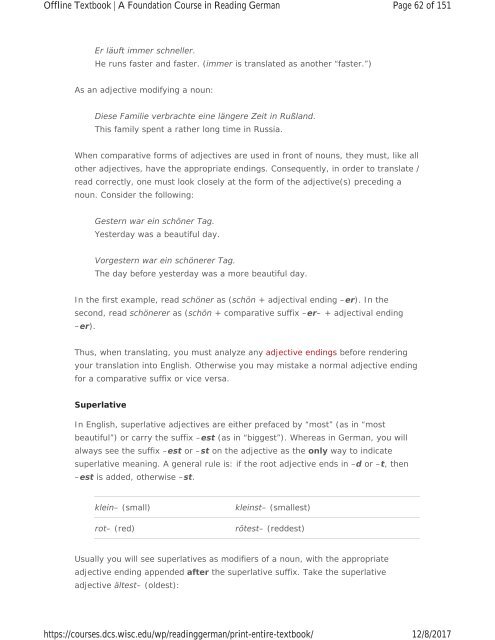A Foundation Course in Reading German, 2017a
A Foundation Course in Reading German, 2017a
A Foundation Course in Reading German, 2017a
Create successful ePaper yourself
Turn your PDF publications into a flip-book with our unique Google optimized e-Paper software.
Offl<strong>in</strong>e Textbook | A <strong>Foundation</strong> <strong>Course</strong> <strong>in</strong> Read<strong>in</strong>g <strong>German</strong><br />
https://courses.dcs.wisc.edu/wp/read<strong>in</strong>ggerman/pr<strong>in</strong>t-entire-textbook/<br />
Page 62 of 151<br />
12/8/2017<br />
Er läuft immer schneller.<br />
He runs faster and faster. (immer is translated as another “faster.”)<br />
As an adjective modify<strong>in</strong>g a noun:<br />
Diese Familie verbrachte e<strong>in</strong>e längere Zeit <strong>in</strong> Rußland.<br />
This family spent a rather long time <strong>in</strong> Russia.<br />
When comparative forms of adjectives are used <strong>in</strong> front of nouns, they must, like all<br />
other adjectives, have the appropriate end<strong>in</strong>gs. Consequently, <strong>in</strong> order to translate /<br />
read correctly, one must look closely at the form of the adjective(s) preced<strong>in</strong>g a<br />
noun. Consider the follow<strong>in</strong>g:<br />
Gestern war e<strong>in</strong> schöner Tag.<br />
Yesterday was a beautiful day.<br />
Vorgestern war e<strong>in</strong> schönerer Tag.<br />
The day before yesterday was a more beautiful day.<br />
In the first example, read schöner as (schön + adjectival end<strong>in</strong>g –er). In the<br />
second, read schönerer as (schön + comparative suffix –er– + adjectival end<strong>in</strong>g<br />
–er).<br />
Thus, when translat<strong>in</strong>g, you must analyze any adjective end<strong>in</strong>gs before render<strong>in</strong>g<br />
your translation <strong>in</strong>to English. Otherwise you may mistake a normal adjective end<strong>in</strong>g<br />
for a comparative suffix or vice versa.<br />
Superlative<br />
In English, superlative adjectives are either prefaced by “most” (as <strong>in</strong> “most<br />
beautiful”) or carry the suffix –est (as <strong>in</strong> “biggest”). Whereas <strong>in</strong> <strong>German</strong>, you will<br />
always see the suffix –est or –st on the adjective as the only way to <strong>in</strong>dicate<br />
superlative mean<strong>in</strong>g. A general rule is: if the root adjective ends <strong>in</strong> –d or –t, then<br />
–est is added, otherwise –st.<br />
kle<strong>in</strong>– (small)<br />
rot– (red)<br />
kle<strong>in</strong>st– (smallest)<br />
rötest– (reddest)<br />
Usually you will see superlatives as modifiers of a noun, with the appropriate<br />
adjective end<strong>in</strong>g appended after the superlative suffix. Take the superlative<br />
adjective ältest– (oldest):


















